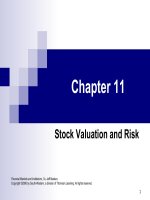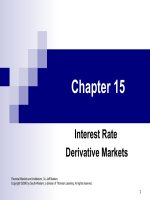Thị trường tài chính và các định chế tài chính_ Chapter 14
Bạn đang xem bản rút gọn của tài liệu. Xem và tải ngay bản đầy đủ của tài liệu tại đây (384.51 KB, 46 trang )
1
Chapter 14
Options Markets
Financial Markets and Institutions, 7e, Jeff Madura
Copyright ©2006 by South-Western, a division of Thomson Learning. All rights reserved.
2
Chapter Outline
Background on options
Speculating with stock options
Determinants of stock option premiums
Explaining changes in option premiums
Hedging with stock options
Using options to measure a stock’s risk
3
Chapter Outline (cont’d)
Options on ETFs and stock indexes
Options on futures contracts
Hedging with options on futures
Institutional use of options markets
Globalization of options markets
4
Background on Options
A call option grants the owner the right to purchase a
specified financial instrument for a specified price
(exercise or strike price) within a specified period of time
Grants the right, but not the obligation, to purchase the specified
investment
The writer of a call option is obligated to provide the instrument
at the price specified by the option contract if the owner
exercises the option
A call option is:
In the money when the market price of the underlying security
exceeds the strike price
At the money when the market price is equal to the strike price
Out of the money when the market price is below the strike price
5
Background on Options (cont’d)
A put option grants the owner the right to sell a
specified financial instrument for a specified
price within a specified period of time
Grants the right, but not the obligation, to sell the
specified investment
A put option is:
In the money when the market price of the underlying
security is below the strike price
At the money when the market price is equal to the strike
price
Out of the money when the market price is above the strike
price
6
Background on Options (cont’d)
Call and put options specify 100 shares for stocks
Premiums paid for call and put options are determined
through open outcry on the exchange floor
Participants can close out their option positions by taking
an offsetting position
The gain or loss is determined by the premium paid when
purchasing the option and the premium received when selling
the option
American-style options can be exercised at any time
prior to expiration
European-style options can be exercise only just before
expiration
7
Background on Options (cont’d)
Markets used to trade options
The CBOE:
Is the most important exchange for trading options
Serves as the market for options on more than 1,500
different stocks
Lists standardized options
Accounts for about 51 percent of all option trading
Options are also traded on the AMEX, Philadelphia
Stock Exchange, Pacific Stock Exchange, and the
International Securities Exchange
8
Background on Options (cont’d)
Markets used to trade options (cont’d)
Listing requirements
Each exchange has its own requirements
One key requirement is a minimum trading volume of the
underlying stocks
Role of the Options Clearing Corporation (OCC)
The OCC serves as a guarantor on option contracts traded in
the U.S.
Regulation of options trading
The SEC and the various option exchanges regulate option
trading
Regulations:
Are intended to ensure fair and orderly training
Attempt to prevent insider trading
Attempt to prevent price fixing among floor brokers
9
Background on Options (cont’d)
How option trades are executed
Floor brokers execute transactions desired by
investors
Some orders are executed electronically without a floor
broker
Market-makers:
Can execute stock option transactions for customers
Trade options on their own account
May facilitate a buy order for one customer and a sell order
for a different customer
Earn the difference between the bid price and the ask price
for the option
10
Background on Options (cont’d)
Types of orders
A market order results in the immediate
purchase or sale of an option at the prevailing
market price
With a limit order, the transaction will occur
only if the market price is no higher or lower
than a specified price limit
Online trading
Many online brokerage firms, like E*Trade and
Datek, facilitate options orders
11
Background on Options (cont’d)
Stock option quotations
Financial newspapers and some local
newspapers publish quotations for stock
options (see next slide)
Options with higher exercise prices have
lower call premiums and higher put premiums
Options with a longer maturity have higher call
option premiums and higher put option
premiums
12
Background on Options (cont’d)
Stock option quotations (cont’d)
Strike Exp. Vol. Call Vol. Put
McDonald’s 45 Jun 180 4 1/2 60 2 3/4
45 Oct 70 5 3/4 120 3 3/4
50 Jun 360 1 1/8 40 5 1/8
50 Oct 90 3 1/2 40 6 1/2
13
Speculating with Stock Options
Speculating with call options
Call options can be used to speculate on the expectation of an
increase in the price of the underlying stock
Assuming that the buyer of the option sells the stock when
exercising the option and that the writer will obtain the stock
only when the option is exercised, the writer’s net gain is the
buyer’s net loss, assuming zero transaction costs
The maximum loss for the buyer of a call option is the premium,
while the maximum gain is unlimited
The maximum gain for the writer of a call option is the premium,
while the maximum loss is unlimited
14
Speculating with Call Options
Pete expects ABC stock to increase from its current price of
$90 per share. He purchases a call option on ABC stock
with an exercise price of $92 for a premium of $4 per
share. ABC stock rises to $97 prior to the option’s
expiration date. If Pete exercises the option and
immediately sells the shares in the market, what is his
net gain from the transaction?
share per 1$4$92$97$ =−−
15
Speculating with Call Options
(cont’d)
Draw the contingency graph for the buyer of the call option
and the writer of the call option.
-4
0
0
4
96
96
Buyer’s Perspective Writer’s Perspective
Profit
Stock Price
At Expiration
16
Speculating with Stock Options
(cont’d)
Speculating with call options (cont’d)
Assume that ABC stock has three call options available:
Call option 1: Exercise price = $87; Premium = $7
Call option 1: Exercise price = $90; Premium = $5
Call option 1: Exercise price = $92; Premium = $4
The risk-return potential varies among the several options that
are available
The contingency graph for all three options is shown on the
next slide
The graph can be revised to reflect returns for each possible price
per share of the underlying stock
17
Speculating with Stock Options
(cont’d)
-4
0
96
Call option 3
Call option 2
95
-5
-7
94
Call option 1
Profit or Loss
Per Share
Stock Price of ABC Stock
18
Speculating with Stock Options
(cont’d)
Speculating with put options
Put options can be used to speculate on the
expectation of a decrease in the price of the
underlying stock
The maximum gain for the buyer of a put option is the
exercise price less the premium, while the maximum
loss is the premium
The maximum loss for the writer of a put option is the
exercise price less the premium, while the maximum
gain is the premium









